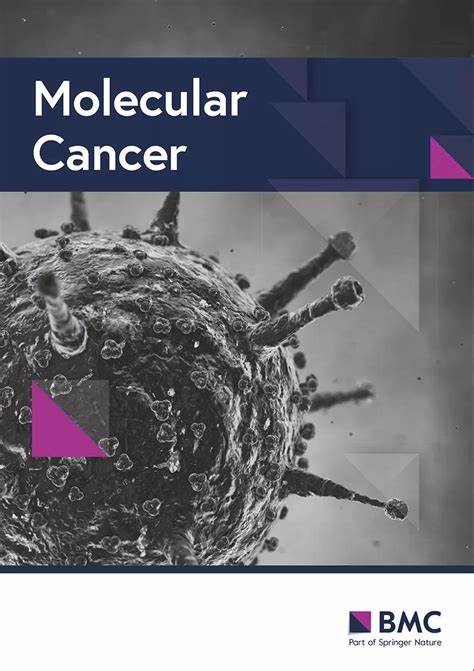用于分子生物学和药物发现的人工智能 alphafold 模型:机器学习驱动的信息学研究
IF 27.7
1区 医学
Q1 BIOCHEMISTRY & MOLECULAR BIOLOGY
引用次数: 0
摘要
AlphaFold 模型重塑了生物学研究。然而,整个 AlphaFold 领域的大量非结构化数据需要进一步分析,以充分了解当前的研究状况并指导未来的探索。因此,本次科学计量学分析旨在利用机器学习驱动的信息学方法,识别关键研究集群,跟踪新兴趋势,并突出该领域中未充分探索的领域。定量统计分析显示,AlphaFold 领域正呈现出惊人的发展趋势(年增长率 = 180.13%)和全球合作(国际合著 = 33.33%)。无监督聚类算法、时间序列跟踪和全球影响力评估指出,聚类 3(人工智能驱动的 AlphaFold 结构生物学进展)的影响力最大(平均引用次数 = 48.36 ± 184.98)。此外,回归曲线和热点迸发分析突出表明,"结构预测"(s = 12.40,R2 = 0.9480,p = 0.0051)、"人工智能"(s = 5.00,R2 = 0.8096,p = 0.0375)、"药物发现"(s = 1.90,R2 = 0.7987,p = 0.0409)和 "分子动力学"(s = 2.40,R2 = 0.8000,p = 0.0405)是推动研究前沿的核心热点。更重要的是,Walktrap 算法进一步揭示了 "结构预测、人工智能、分子动力学"(相关百分比[RP] = 100%,发展百分比[DP] = 25.0%)、"sars-cov-2、covid-19、疫苗设计"(RP = 97.8%,DP = 37.5%)和 "同源建模、虚拟筛选、膜蛋白"(RP = 89.9%,DP = 26.1%)与 AlphaFold 模型密切相关,但仍未得到充分开发,这意味着还有广阔的探索空间。总之,通过机器学习驱动的信息学方法,本次科学计量学分析客观、全面地概述了全球AlphaFold研究,确定了关键的研究集群和热点,同时前瞻性地指出了尚未充分开发的关键领域。本文章由计算机程序翻译,如有差异,请以英文原文为准。
Artificial intelligence alphafold model for molecular biology and drug discovery: a machine-learning-driven informatics investigation
AlphaFold model has reshaped biological research. However, vast unstructured data in the entire AlphaFold field requires further analysis to fully understand the current research landscape and guide future exploration. Thus, this scientometric analysis aimed to identify critical research clusters, track emerging trends, and highlight underexplored areas in this field by utilizing machine-learning-driven informatics methods. Quantitative statistical analysis reveals that the AlphaFold field is enjoying an astonishing development trend (Annual Growth Rate = 180.13%) and global collaboration (International Co-authorship = 33.33%). Unsupervised clustering algorithm, time series tracking, and global impact assessment point out that Cluster 3 (Artificial Intelligence-Powered Advancements in AlphaFold for Structural Biology) has the greatest influence (Average Citation = 48.36 ± 184.98). Additionally, regression curve and hotspot burst analysis highlight “structure prediction” (s = 12.40, R2 = 0.9480, p = 0.0051), “artificial intelligence” (s = 5.00, R2 = 0.8096, p = 0.0375), “drug discovery” (s = 1.90, R2 = 0.7987, p = 0.0409), and “molecular dynamics” (s = 2.40, R2 = 0.8000, p = 0.0405) as core hotspots driving the research frontier. More importantly, the Walktrap algorithm further reveals that “structure prediction, artificial intelligence, molecular dynamics” (Relevance Percentage[RP] = 100%, Development Percentage[DP] = 25.0%), “sars-cov-2, covid-19, vaccine design” (RP = 97.8%, DP = 37.5%), and “homology modeling, virtual screening, membrane protein” (RP = 89.9%, DP = 26.1%) are closely intertwined with the AlphaFold model but remain underexplored, which implies a broad exploration space. In conclusion, through the machine-learning-driven informatics methods, this scientometric analysis offers an objective and comprehensive overview of global AlphaFold research, identifying critical research clusters and hotspots while prospectively pointing out underexplored critical areas.
求助全文
通过发布文献求助,成功后即可免费获取论文全文。
去求助
来源期刊

Molecular Cancer
医学-生化与分子生物学
CiteScore
54.90
自引率
2.70%
发文量
224
审稿时长
2 months
期刊介绍:
Molecular Cancer is a platform that encourages the exchange of ideas and discoveries in the field of cancer research, particularly focusing on the molecular aspects. Our goal is to facilitate discussions and provide insights into various areas of cancer and related biomedical science. We welcome articles from basic, translational, and clinical research that contribute to the advancement of understanding, prevention, diagnosis, and treatment of cancer.
The scope of topics covered in Molecular Cancer is diverse and inclusive. These include, but are not limited to, cell and tumor biology, angiogenesis, utilizing animal models, understanding metastasis, exploring cancer antigens and the immune response, investigating cellular signaling and molecular biology, examining epidemiology, genetic and molecular profiling of cancer, identifying molecular targets, studying cancer stem cells, exploring DNA damage and repair mechanisms, analyzing cell cycle regulation, investigating apoptosis, exploring molecular virology, and evaluating vaccine and antibody-based cancer therapies.
Molecular Cancer serves as an important platform for sharing exciting discoveries in cancer-related research. It offers an unparalleled opportunity to communicate information to both specialists and the general public. The online presence of Molecular Cancer enables immediate publication of accepted articles and facilitates the presentation of large datasets and supplementary information. This ensures that new research is efficiently and rapidly disseminated to the scientific community.
 求助内容:
求助内容: 应助结果提醒方式:
应助结果提醒方式:


